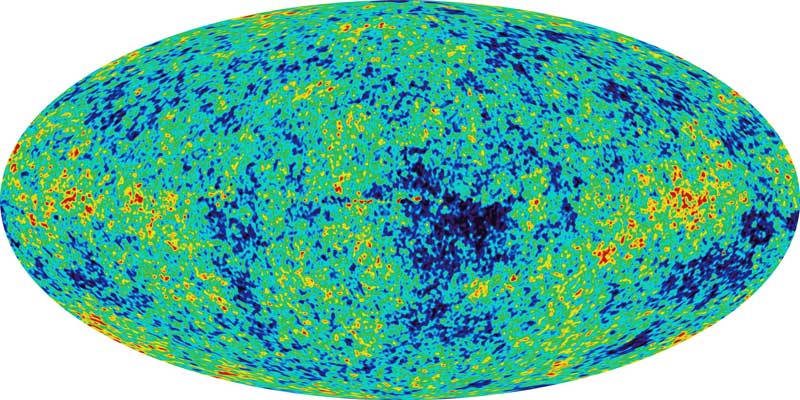A direct link to the above video is at http://www.youtube.com/watch?v=G7iFXPU_1YE
This new YouTube video accompanies my blog entry from a few months ago: Looking at We Start.
A direct link to the above video is at http://www.youtube.com/watch?v=oknxMPMhCLo
Here's an image generated by data from WMAP, the Wilkinson Microwave Anisotropy Probe. According to WMAP's results, our universe is flat to within a 2% margin of possible error. Is our universe really flat? I believe that it isn't.
 Remember this: our universe is not just space. If you are traveling in space you are really traveling in spacetime, unless you've discovered some way to instantly transport to a distant star using no time whatsoever.
Remember this: our universe is not just space. If you are traveling in space you are really traveling in spacetime, unless you've discovered some way to instantly transport to a distant star using no time whatsoever.
Here's one way I saw the concept of a perfectly flat universe within the multiverse explained.
If spacetime is absolutely flat, then if you were to set off in a rocket ship and travel in a single direction, you would eventually get to the universe that's just like the one you're in now, but where you got up an hour later this morning, or where Michael Jackson is still alive. And if you continued on this journey, eventually you would start getting to the other universes with basic physical laws, the other universes of the multiverse.
So. There is evidence that spacetime is close to flat, but I still feel certain that it will be proved that there is a certain very small curvature to spacetime, which is why our universe is not really infinite, it's finite but unbounded. It's like the old video games where going off the top of the screen gets you to the bottom, or going off the left gets you to the right (or traveling on the equator eventually gets you back to where you started). To continue the analogy, our observed spacetime universe and its cosmic horizon would be a tiny dot in the middle of that video game screen: we've talked about this in entries like Finite But Unbounded and An Expanding 4D Sphere, how some cosmologists say that if this dot representing our observable universe were the size of a quarter, this "video game screen" we're thinking about here would be the size of planet Earth.
Now, in a finite but unbounded universe with a slight curvature, if you were to set off in a rocket ship and travel in one direction, you would traverse the finite but unbounded hypersphere of spacetime, and eventually end up back where you started. Or with a slight change in trajectory, you could end up in the universe where you got up an hour later this morning, or where Michael Jackson is still alive... or any of the other possible versions of our universe that are part of the wave function of outcomes which could have or will have occurred for our particular universe with its locked in fine structure constant.
The other "perfectly flat spacetime" explanation we looked at above has its supporters, I think, because it still allows the viewpoint that free will is an illusion and everything is inevitable. If you eventually get to that universe where Michael Jackson is still alive using flat spacetime, then where you get to is really completely unrelated and causally unconnected to our own version of spacetime! No wonder some people who are shown this theory reject the idea of parallel universe versions of our universe even existing. And where that model breaks down further for me is that we have to eventually encounter an "edge" to our spacetime universe where the basic physical laws become fuzzy, and we somehow transition into the spacetime "edge" of a different universe with a different fine structure constant.
The slightly curved spacetime model works better for me because it seems much more likely that the universe where you got up an hour later this morning is directly connected to the universe we're in, and that the spacetime tree of possible outcomes connected to "now" has its branches within the fifth dimension. It also explains why no matter how far out into spacetime we look, we're never going to see other universes with different physical laws - because getting to those other universes would require extra dimensional movement within the seventh dimension and above (or to use the string theory perspective, it would require us to break out of the D7 brane our universe is embedded within), and arriving at a new "point" within that multiverse landscape would reveal some other universe that is apparently infinite within its version of spacetime, but is really just as finite but unbounded as our own.
Next time, we'll be looking at the video for one of my favorite blog entries from 2010, "Light Has No Speed" in a new entry called Photons and Free Will. Enjoy the journey!
Rob Bryanton
Saturday, January 15, 2011
Is Spacetime Flat or Curved?
Reading: Is Spacetime Flat or Curved?Post Link to Twitter
Posted by
Rob Bryanton
at
3:18 AM
![]()
Labels: fifth dimension, visualizations
Subscribe to:
Post Comments (Atom)






1 comment:
Is Spacetime Flat or Curved ?
Many cosmologists believe that '' spacetime is curved ''
====
The spacetime (as whole ) is cold continuum.
The light travels in this continuum in a straight line.
But near the hot masses of stars light can be curved.
Not spacetime curves but the movement of light is curved by hot masses.
#
Sun changes the road of light like a car changes its movement by road
but Euclidian geometry of Earth remains unchanged.
#
Sun (and its surrounded space) curves the straight movement of light quanta,
but the geometry of Pseudo Euclidian (Minkovski ) spacetime remains unchanged.
=====================
Israel Sadovnik Socratus
Post a Comment